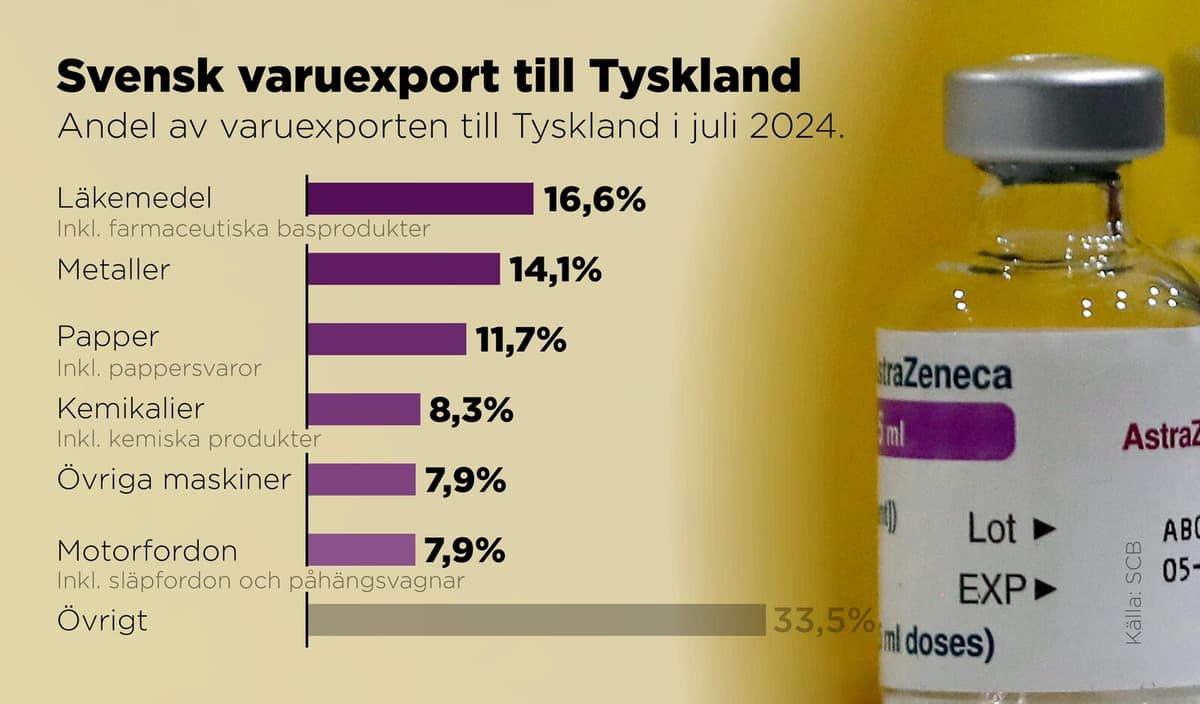It's going slow for the EU's largest economy. Last year, the German economy shrank by 0.3 percent. This year, a slight recovery was expected, but that scenario appears to be just a memory.
Economic institutes foresee that growth will contract again.
The German economy is in stagnation, it's not growing at all. And it's been like that for a while, says Pia Fromlet, euro economist at SEB.
The third quarter of this year did not bring much hope for a brightening of the economic horizon, according to the German research institute Ifo. Klaus Wohlrabe at Ifo warns that Germany's economy is "stuck in crisis".
Behind the curve
But why is it going so slow? According to Pia Fromlet, there are several factors that have given Germany a tough uphill battle, and it still faces major challenges ahead.
Like many other countries, Germany is struggling with demographic challenges – low growth in the working-age population. It has also invested too little in sectors such as energy, infrastructure, and digitalization, Fromlet believes. Moreover, the energy transition has been anything but smooth.
And as if that weren't enough, the industry is still doing poorly, not least the crucial automotive industry. Decreased demand has led Volkswagen to raise a warning flag that it may be forced to close factories at home. Even Mercedes Benz has seen its sales figures decline.
There are major transformation problems towards increased electrification. They were not very keen on abandoning diesel cars and have been a bit slow to jump on the electrification bandwagon. China has come up with cheaper electric cars, and German companies have lost market shares in China. And China is extremely important for Germany when it comes to the car market, says Pia Fromlet.
The downturn is also affecting Sweden. The fact that the technology and automotive industries are doing poorly is particularly bad for the basic industry in Sweden, according to Industriarbetsgivarna. The majority of what is produced within the basic industry, i.e., mining and mineral industry, forestry industry, paper industry, and metal industry, is exported.
Germany is by far the largest export market for the basic industry. Around 20 percent of what is produced in steel and metal goes to Germany, and for the forestry industry, it's about 15 percent, says Kerstin Hallsten at the employers' organization.
Worse than expected
Is it worrying that Germany is doing so poorly?
It absolutely is. It's a challenge in general for Sweden, which has significant exports to Germany, and in particular for the basic industry, where Germany is the major recipient country.
Germany has long been an important trading partner for Sweden and is also Sweden's largest export market, ahead of Norway and the USA. It's not least about paper products, metals, machinery, vehicles, and chemical products. Between January and July this year, exports to Germany accounted for 10.2 percent of all Swedish exports, a slight decrease compared to last year.
Industriarbetsgivarna notes that many of its members generally see tougher times ahead.
The impression is that the situation this autumn is a bit worse than they had expected, says Kerstin Hallsten.
Pia Fromlet at SEB believes that Swedish exports have been resilient, and one explanation could be the weak krona. However, the weak German economy may be a risk for Swedish exports going forward.
The German industrial cycle needs to pick up for Swedish exports to hold up. It will be tough to grow if the German industrial cycle doesn't get going again, since Germany is Sweden's most important export nation.
"There is hope"
It's not just Sweden that's dependent on Germany.
Other countries in Europe are also very dependent on Germany. The Netherlands and France are important trading partners to Germany, which in turn is important for Sweden. The entire trade flow in Europe is very dependent on Germany, says Pia Fromlet.
If Germany is to get its economy back on track, significant efforts are needed, she believes. Germany has relatively strong public finances compared to other countries in the euro area, such as Spain and France, but the German government is bound by its own fiscal policy rules.
A package of measures to revitalize the economy has been presented, including investments in infrastructure and measures to reduce bureaucracy. They also want to make it easier for companies that have been hard hit by high energy prices and attract more qualified labor from other countries.
Germany has had crises before and gotten out of them. So, there is hope for Europe's largest economy. But they need to work on reducing the high cost level, the energy transition is necessary, and reforms are needed for long-term growth – they need to invest more, says Pia Fromlet.
Germany continues to be Sweden's largest export market. This year, Norway has overtaken the USA as the second-largest export market.
1. Germany: 10.2 percent of Sweden's exports
2. Norway: 9.6 percent
3. USA: 9.3 percent
4. Finland: 6.6 percent
5. Denmark: 6.5 percent
6. Netherlands: 5.4 percent
7. United Kingdom and Northern Ireland: 5.4 percent
8. Belgium: 4.8 percent
9. France: 4.2 percent
10. China: 4.0 percent
The figures apply to the period January-July 2024.
Source: Statistics Sweden (SCB)
Sweden exports many different products to Germany, but forestry, machinery, and chemical products are some of the largest product categories.
Amounts for July 2024. Corresponding period 2023 in parentheses.
Pharmaceutical base products and medicines:
2.6 billion kronor (1.5 billion)
Metals:
2.2 billion kronor (1.6 billion)
Paper and paper products:
1.8 billion kronor (1.9 billion)
Chemicals and chemical products:
1.3 billion kronor (1 billion)
Other machinery, such as agricultural and forestry machinery:
1.3 billion kronor (1.5 billion)
Source: Statistics Sweden (SCB)





